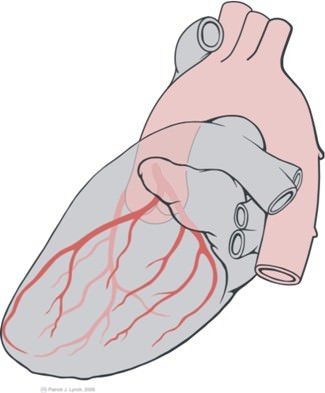3.3 肺循环和系统循环
章节大纲
-
How does oxygen get into the ?
::氧气如何进入?The main function of the circulatory system is to pump blood carrying oxygen around the body. But how does that oxygen get into the blood in the first place? You may already know that this occurs in the lungs . So the blood must also be pumped to the lungs, and this happens separately from the circulation to the rest of the body.
::循环系统的主要功能是泵血液携带身体的氧气。 但氧气是如何进入血液的? 您可能已经知道肺部会发生这种情况。 因此血液也必须抽入肺部, 这与向身体其他部位的循环是分开的。Pulmonary and Systemic Circulations
::肺循环和循环循环The double circulatory system of blood flow refers to the separate systems of pulmonary circulation and systemic circulation in , , and mammals (including humans). The adult human heart consists of two separated pumps: the right side, which pumps deoxygenated blood into the pulmonary circulation, and the left side, which pumps oxygenated blood into the systemic circulation. Blood in one circuit has to go through the heart to enter the other circuit, as shown in Figure .
::血液流动的双循环系统是指肺循环和在哺乳动物(包括人类)和哺乳动物(包括人类)中系统循环的单独系统。成年人类心脏由两个分离的泵组成:右侧,将脱氧血液泵入肺循环,左侧,将氧血液泵入系统循环。如图所示,一个循环中的血液必须穿过心脏进入另一循环。The double circulatory system. Blood in one circuit has to go through the heart to enter the other circuit. The heart-to-lungs-to-heart portion is the pulmonary circulation, and the heart-to-body-to-heart portion is the systemic circulation.
::双循环系统。 一条电路中的血液必须穿过心脏才能进入另一条电路。 心到肺到心部分是肺循环, 心到身体到心部分是系统循环。Pulmonary Circulation
::肺循环The pulmonary circulation is the portion of the that carries oxygen-poor (deoxygenated) blood from the heart to the lungs and returns oxygenated blood back to the heart. As shown in Figure , deoxygenated blood from the body leaves the right ventricle through the pulmonary arteries , which carry the blood to each lung. The pulmonary arteries are the only arteries that carry deoxygenated blood. In the lungs, red blood cells release carbon dioxide and pick up oxygen during respiration . The oxygenated blood then leaves the lungs through the pulmonary veins , which return it to the left side of the heart and complete the pulmonary cycle. The oxygenated blood is then distributed to the body through the systemic circulation before returning again to the pulmonary circulation.
::肺循环是将缺氧(脱氧)血液从心脏带入肺部,再将氧化血液带回心脏的部分。如图所示,身体脱氧血液通过肺动脉将右心室从右侧移开,将血液带入肺部。肺动脉是携带脱氧血液的唯一动脉。在肺部,红血细胞释放二氧化碳,在呼吸过程中提取氧气。氧化血液然后通过肺血管将肺部从肺部释放出来,再回到心脏的左侧,完成肺循环。然后,氧化血液通过系统循环传播到身体,然后再返回肺循环。The pulmonary circulation carries blood between the heart and lungs.
::肺循环在心脏和肺间传播血液。The pulmonary circulation was first discovered by a Syrian physician, Ibn al-Nafis, in 1242. However, credit for the first description of blood circulation is given to an English medical doctor, William Harvey, who described in detail the pulmonary and systemic circulation systems in 1616.
::肺循环是叙利亚医生Ibn al-Nafis于1242年首次发现的,但是,对血液循环的第一个描述归功于英国医生William Harvey,他详细描述了1616年的肺循环和系统循环系统。Systemic Circulation
::系统循环The systemic circulation is the portion of the cardiovascular system that carries oxygenated blood from the heart to the body and returns deoxygenated blood back to the heart. Oxygenated blood from the lungs leaves the left ventricle through the aorta . From here it is distributed to the body's organs and tissues , which absorb the oxygen through a complex network of arteries, arterioles, and capillaries. The deoxygenated blood is then collected by venules and flows into veins before reaching the inferior and superior venae cavae, which return it to the right heart, completing the systemic cycle (see Figure ). The blood is then re-oxygenated through the pulmonary circulation before returning again to the systemic circulation.
::系统循环是心血管系统的一部分,将氧化血液从心脏带入身体,再将脱氧血液带回心脏,肺中的氧化血液将左心室通过动脉释放。从这里向身体的器官和组织分配,通过由动脉、动脉和辣椒组成的复杂网络吸收氧气。脱氧血液然后通过输卵管收集,流到血管中,然后到达低等和高等的葡萄树叶,然后返回右心,完成系统循环(见图 )。然后血液再通过肺循环再氧,然后返回到系统循环。The systemic circulation. The systemic circulation brings oxygenated blood to the body cells and tissues and transports cellular wastes away from the cells and tissues. It is also responsible for temperature regulation and transport of hormones and other substances around the body.
::系统循环:系统循环将氧化血液带入身体细胞和组织,将细胞废物运离细胞和组织,还负责温度调节和荷尔蒙和其他物质在身体周围的迁移。Just like every other organ in the body, the heart needs its own blood supply, which it gets through the coronary circulation. Although blood fills the chambers of the heart, the heart muscle tissue is so thick that it needs to deliver oxygen and nutrients deep within it. The vessels that deliver oxygen-rich blood to the heart muscle are called coronary arteries; they branch directly from the aorta, just above the heart, as shown in Figure . The vessels that remove the deoxygenated blood from the heart muscle are known as cardiac veins.
::心脏和身体中的其他器官一样,需要自己的血液供应,这通过冠心循环得到。虽然血液填满了心脏的腹部,但心脏肌肉组织非常厚,需要提供氧气和体内的营养。向心脏肌肉输送含氧血液的血管被称为冠心动脉;它们直接从动脉中切入,就在心脏上方,如图所示。从心脏肌肉中去除脱氧血液的血管被称为心脏血管。This side view (lateral view) of the heart shows how the coronary arteries (in red) branch directly from the aorta to bring oxygen and nutrients into the heart muscle.
::心脏的这一侧视图(边视图)显示动脉(红动脉)如何直接从动脉中导出氧和营养物质进入心脏肌肉。Portal Venous System
::门户排入系统A portal venous system occurs when a capillary bed drains into another capillary bed through veins. They are relatively uncommon, as the majority of capillary beds drain into the heart, not into another capillary bed. Portal venous systems are considered venous because the blood vessels that join the two capillary beds are either veins or venules.
::当毛细病床通过静脉排入另一个毛细病床时,就出现了一个门户通关系统。 它们相对罕见,因为大部分毛细病床排入心脏,而不是另一个毛细病床。 门户通通通通系统被认为是有毒的,因为连接两个毛细病床的血管要么是血管,要么是输血管。An example of a portal venous system is the blood vessel network between the digestive tract and the liver . The hepatic portal system is responsible for directing blood from parts of the gastrointestinal tract to the liver. Nutrients that have been absorbed into the blood from the are taken to the liver for processing before being sent to the heart. The term "portal venous system" often refers to the hepatic portal system.
::入口静脉系统的一个例子是消化道和肝脏之间的血管血管网络。肝脏切口系统负责将胃肠道部分的血液引向肝脏。从血液中吸收到肝脏中的营养物在被送入心脏之前被送往肝脏处理。“口腔静脉系统”一词通常指肝脏切口系统。Summary
::摘要-
The pulmonary circulation is the portion that brings blood to the lungs and back.
::肺循环是肺部和背部 血液传播的部分 -
The systemic circulation is the portion that brings oxygenated blood to the rest of the body.
::系统循环是给身体其他部位带来氧化血液的部分。 -
The heart gets its own supply of blood through the coronary circulation. Coronary arteries deliver oxygenated blood from the aorta to the heart. Cardiac veins remove deoxygenated blood from the heart.
::冠状动脉将氧化的血液从动脉输送到心脏。心血管将去氧化的血液从心脏中取出。 -
Portal venous systems involve a system where capillary beds are connected to other capillary beds through veins.
::门户静脉系统涉及一个通过静脉将毛细床与其他毛细床连接起来的系统。
Review
::回顾-
What does the double circulatory system refer to?
::双循环系统指的是什么? -
What is the difference between pulmonary circulation and systemic circulation?
::肺循环与系统性循环之间有什么区别? -
Why does the heart need its own blood supply if it is filled with blood?
::为什么心脏需要自己的血液供应 如果充斥着血液呢? -
Give an example of a portal venous system in the human body.
::举个例子来说明 人体的入口有毒系统
-
The pulmonary circulation is the portion that brings blood to the lungs and back.




